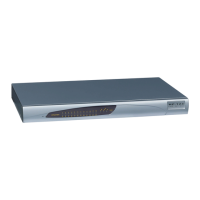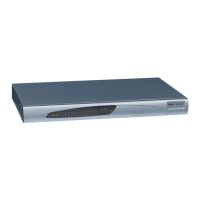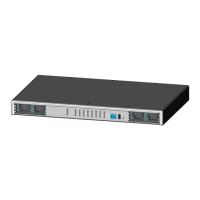Version 7.2 449 Mediant 1000B Gateway & E-SBC
User's Manual 21. Digital PSTN
• The read-only 'Module ID' field displays the module number to which the trunk
belongs.
• The read-only 'Trunk ID' field displays the selected trunk number.
• The read-only 'Trunk Configuration State' displays the status of the trunk:
♦ "Not Configured": Trunk is not configured.
♦ "Active": Configured trunk is active.
♦ "Inactive": Configured trunk is stopped (inactive).
• The displayed parameters pertain to the selected trunk only.
3. Click the Stop Trunk button (located at the bottom of the page) to take the trunk out of
service so that you can configure the currently grayed out (unavailable) parameters.
(Skip this step if you want to configure parameters that are available when the trunk is
active). The stopped trunk is indicated by the following:
• The 'Trunk Configuration State' field displays "Inactive".
• The Stop Trunk button is replaced by the Apply Trunk Settings button. When
all trunks are stopped, the Apply to All Trunks button also appears.
• All the parameters are available and can be modified.
4. Configure the trunk parameters as required.
5. Click the Apply Trunk Settings button to apply the changes to the selected trunk (or
click Apply to All Trunks to apply the changes to all trunks); the Stop Trunk button
replaces Apply Trunk Settings and the ‘Trunk Configuration State’ displays "Active".
6. Reset the device with a save-to-flash for your settings to take effect.
21.2 TDM and Timing
This section describes the configuration of the TDM and clock timing parameters.
21.2.1 TDM Bus Clock Settings
In a traditional TDM service network such as PSTN, both ends of the TDM connection must
be synchronized. If synchronization is not achieved, voice frames are either dropped (to
prevent a buffer overflow condition) or inserted (to prevent an underflow condition). In both
cases, connection quality and reliability is affected.
PSTN line clock (see ''Recovering Clock from PSTN Line'' on page 449)
Internal clock (see ''Configuring Internal Clock as Clock Source'' on page 450)
Note: When the device is used in a ‘non-span’ configuration, the internal device
clock must be used (as explained above).
21.2.1.1 Recovering Clock from PSTN Line Interface
This section provides a brief description for configuring synchronization based on
recovering clock from the PSTN line interface. For a full description of the clock
parameters, see ''PSTN Parameters'' on page 1074.
To configure synchronization based on clock from PSTN line:
1. Open the TDM Bus Settings page (Setup menu > Signaling & Media tab > Media

